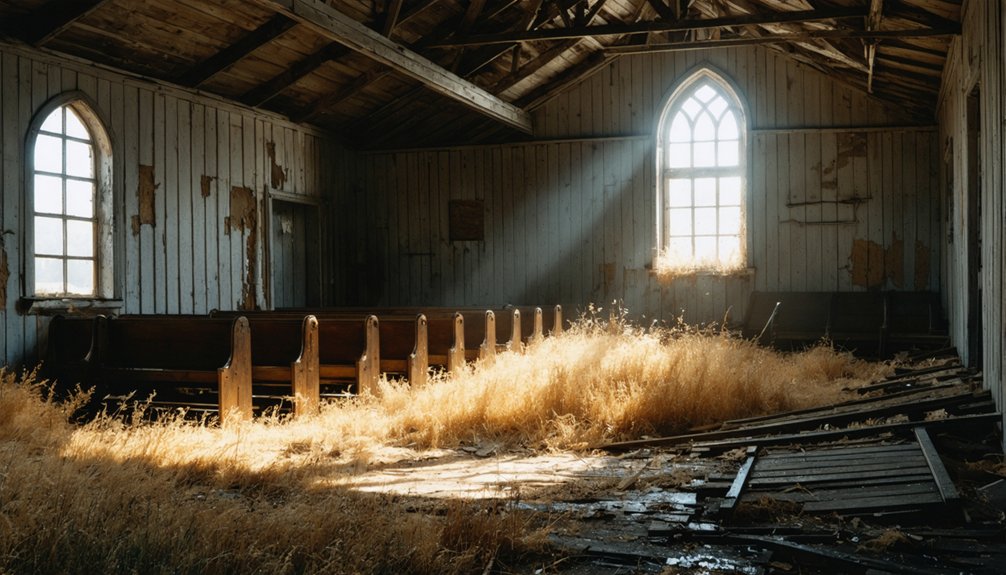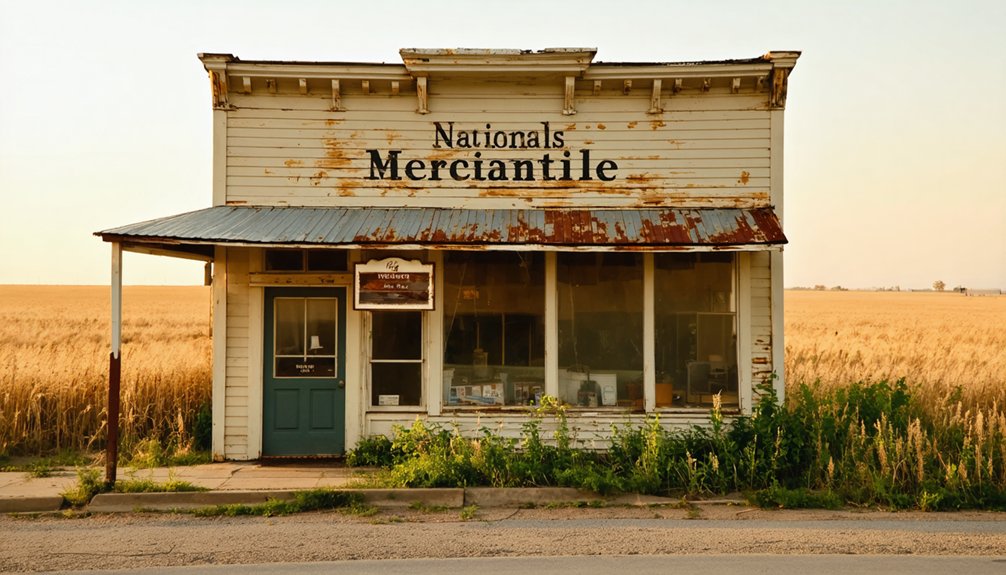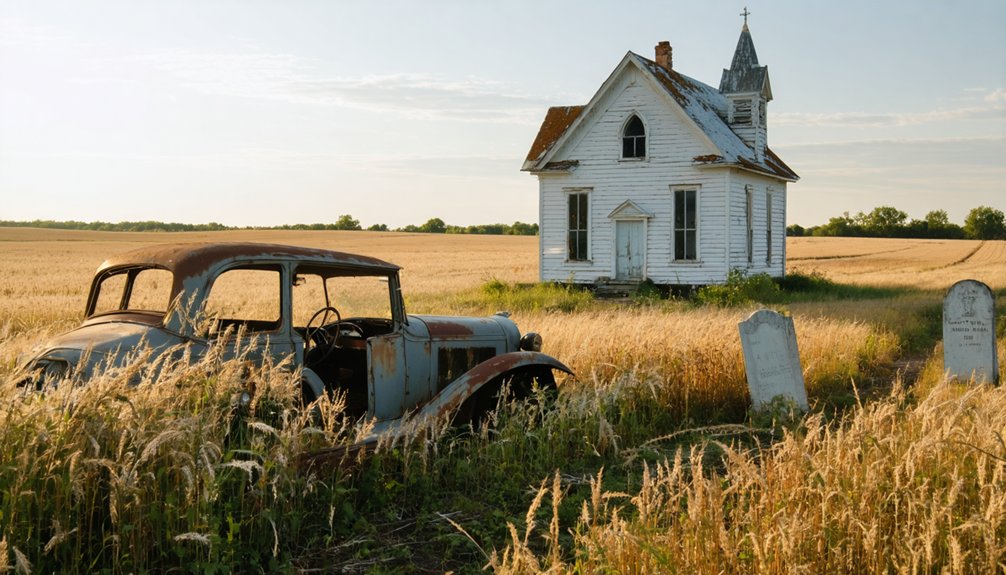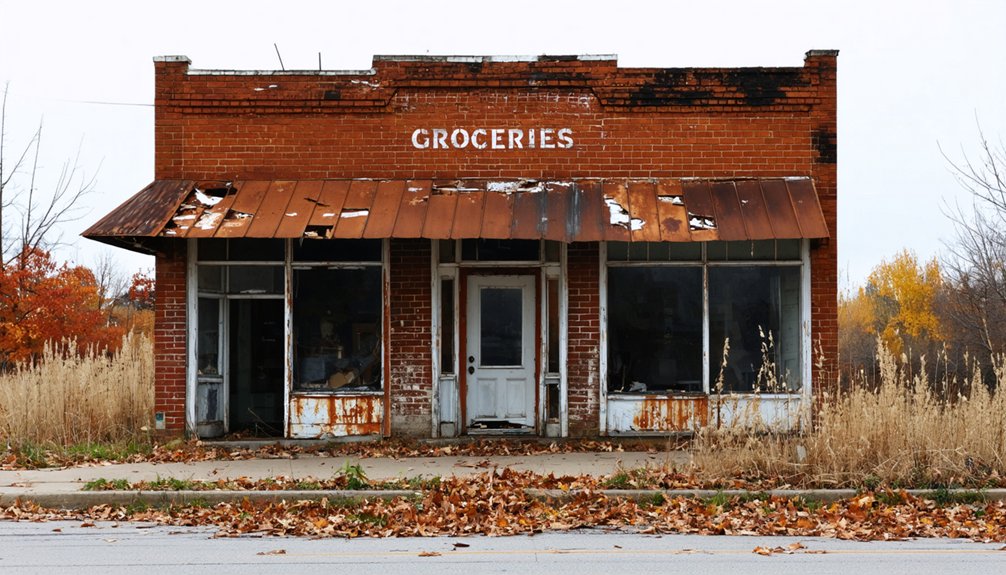You’ll find National, Iowa’s story in its rise and fall as an essential mid-19th century railroad hub. The town flourished between major rail lines, with the Chicago & Rock Island and Chicago & North Western railways establishing important connections. When the shift from coal to diesel fuel occurred in the mid-1900s, National’s mining operations collapsed, triggering mass exodus. Today, crumbling buildings and an old cemetery offer silent testimony to this once-bustling community’s deeper historical significance.
Key Takeaways
- National emerged as a strategic railroad hub in mid-19th century Iowa, positioned between major rail routes operated by Rock Island and Chicago & North Western.
- The town’s economy relied heavily on coal mining operations and railroad maintenance, providing hundreds of jobs during its peak.
- The transition from coal to diesel fuel in the mid-20th century triggered the town’s decline and mass population exodus.
- By the late 1950s, National was completely abandoned, with buildings left to deteriorate and residents relocating to larger towns.
- Today, visitors can explore the cemetery with historical headstones, though deteriorating structures are off-limits due to safety concerns.
The Rise of National as a Railroad Hub
As railroads expanded across Iowa in the mid-19th century, National emerged as a strategic hub along the growing network of rail lines.
You’d find the town positioned perfectly between major routes, with multiple rail companies like Rock Island and Chicago & North Western establishing essential connections through the area.
Railroad development transformed National into a significant logistics center, where crews switched trains, performed maintenance, and managed freight operations. By the mid-1850s, the Chicago & Rock Island became one of the first major railroads to connect Iowa to Chicago. Today, the Iowa Interstate Railroad operates over 580 miles of these historic routes.
The economic impact was substantial – hundreds of workers found employment in the railroad shops and switching yards.
You could see the town’s importance grow as Iowa’s rail network expanded from 2,683 miles in 1870 to over 9,200 miles by 1900, making National a key junction for both transcontinental traffic and local agricultural shipments.
Daily Life in Early National
In early National, you’d find commerce centered around essential trading posts where settlers bartered agricultural goods, supplies, and services to sustain their growing community.
The town’s school and church buildings served as crucial institutions, with the schoolhouse hosting seasonal classes around farming schedules while the church provided spiritual and social support.
Community events brought settlers together through barn raisings, harvest celebrations, and regular church gatherings that strengthened social bonds in the developing settlement. The transition from subsistence farming to commodity-focused agriculture in the 1850s dramatically changed how residents structured their daily work and trade activities. Many settlers traded valuable lead ore at local posts, following practices established by Julien Dubuque decades earlier.
Commerce and Trading Posts
Trading posts formed the economic backbone of early National, Iowa, where Native American tribes, European merchants, and American traders converged to exchange goods in a complex network of commerce.
You’d find the trading dynamics revolved around valuable pelts – beaver, muskrat, and mink – which local tribes would exchange for metal tools, firearms, and textiles. The barter systems relied heavily on skilled negotiation, often conducted through sign language or interpreters. To ensure security, merchants implemented verification processes to protect their trading connections. Many traders secured business relationships by engaging in marriage alliances with daughters of tribal chiefs.
During peak seasons in spring and fall, you’d see a flurry of activity as traders like the Phelps family and John Gilbert established crucial connections with Meskwaki leaders.
These posts didn’t just facilitate trade; they served as essential supply hubs for both Native communities and westward-bound settlers until declining fur populations and Native displacement transformed the region’s economy.
School and Church Life
Beyond the bustling trading posts, National’s social fabric centered on its schools and churches, which shaped daily life throughout the community’s existence.
You’d find modern school architecture featuring boiler heating and electric lighting, with buildings that served multiple purposes – from academic instruction to community gatherings.
During weekdays, you could hear children reciting lessons in reading, writing, and arithmetic, while religious education formed a cornerstone of their learning.
Schools like Farrar and Oak Park Academy offered both day and boarding options, adapting to local needs. These educational centers often spanned over 17,000 square feet, serving students from numerous surrounding communities.
The buildings often stood near cemeteries or churches, hosting everything from band concerts to wedding celebrations.
When harvest season called, students might be absent, but these essential institutions remained steadfast centers of community life.
The Seventh Day Adventist influence remained strong in the area, with an active church still operating near the old academy grounds.
Social Gatherings and Events
Life in early National revolved around its vibrant social spaces, where you’d find residents gathering at the general stores, post office, and wagon shops that dotted the landscape from 1847 onward.
You’d catch up on local news while picking up supplies or waiting for mail at the post office, established in 1858. Community celebrations often centered around seasonal activities, with social networks forming through shared labor and commerce. Similar to Buxton’s Emancipation Day festivities, these events brought townsfolk together to strengthen community bonds.
The wagon shops, operating from 1867-1873 and again from 1879-1891, weren’t just places of business – they served as hubs where you’d forge connections with fellow townspeople. The town’s eventual decline mirrored many others where improved transportation methods in the mid-1900s drew residents to larger towns for shopping.
As businesses gradually relocated to nearby Logan in the late 1800s, these cherished gathering spots diminished, forever changing the fabric of National’s once-bustling social scene.
Economic Activities and Local Commerce
The economic foundation of National, like many Iowa ghost towns, rested firmly on coal mining operations that shaped every aspect of local commerce and daily life.
You’d have found mining wages that surpassed typical agricultural work, attracting diverse workers from across the country. These earnings, subject to seasonal fluctuations, fueled a vibrant local economy.
The town’s commercial hub centered around company stores and independent merchants who served both miners and surrounding farmers.
If you’d visited National during its peak, you’d have encountered a bustling marketplace where cash transactions dominated, though some bartering still occurred.
The railroad’s presence proved essential, connecting National to broader markets and ensuring a steady flow of manufactured goods from eastern states while facilitating coal shipments to hungry industrial centers.
The Decline and Abandonment

When railroads switched from coal to diesel fuel in the mid-20th century, National’s mining operations faced an insurmountable decline that would seal the town’s fate.
The economic shifts hit the community hard, triggering a rapid population migration as residents sought opportunities elsewhere. You’ll find that National’s story mirrors many Iowa mining towns that couldn’t survive the changing times.
The town’s final chapter unfolded through these key events:
- Loss of essential services, including the post office and general store
- Deterioration of mining infrastructure and company housing
- Complete abandonment by the remaining families by the late 1950s
Without maintenance, National’s buildings crumbled into the landscape.
Today, you won’t find much more than scattered foundations and overgrown paths where streets once connected this once-thriving mining community.
Remaining Landmarks and Structures
Modern visitors to National’s remnants might be surprised to learn that several significant structures from Buckhorn, Iowa still stand as silent witnesses to the town’s past.
You’ll find three remaining structures clustered near each other: a whitewashed church with its classic rural Iowa design, an abandoned creamery with partially intact walls and roof, and a hilltop cemetery that chronicles generations of local residents.
While you can’t enter the deteriorating church or creamery due to private ownership and safety concerns, their architectural significance is evident from the exterior.
The creamery’s size hints at the area’s once-thriving dairy industry. The cemetery remains accessible, featuring headstones that tell the story of Buckhorn’s former inhabitants, though no new burials take place there.
Historical Legacy and Preservation Efforts

Despite National’s physical decline, preservation efforts across Iowa have worked to document and protect ghost towns like this one through various state and local initiatives.
You’ll find thorough ghost town documentation through Iowa’s State Historic Preservation Office, which implements a strategic ten-year preservation plan focused on protecting these vanishing landmarks.
Key preservation initiatives you can explore include:
- Historical Resource Development Program grants supporting emergency preservation and site surveys
- Crawford County’s interactive mapping project identifying forgotten towns
- Local historical societies’ educational programs highlighting ghost town heritage
These efforts guarantee that even as physical structures fade, National’s story remains preserved through historical records, photographs, and oral histories – maintaining an important connection to Iowa’s pioneering past for future generations.
Frequently Asked Questions
Were There Any Notable Crimes or Lawlessness in National’s History?
Like a fading echo through time, you won’t find specific crime statistics or law enforcement records for National. The town’s brief existence left behind no documented cases of notable lawlessness.
What Indigenous Peoples Lived in the National Area Before Settlement?
You’ll find the Sac and Fox (Meskwaki) tribes were the primary Native Tribes in your area, with deep cultural heritage including farming and trading. The Oneota culture preceded them around 900 A.D.
How Did Severe Weather Events Affect National’s Development?
You’d find severe storms and floods repeatedly devastated National’s infrastructure, disrupting rail connections and farming. These weather events drove away residents and businesses, creating lasting economic impact that hastened the town’s decline.
Did Any Famous People Ever Visit or Live in National?
You won’t find any records of famous visitors or celebrity sightings in National. The small railroad stop didn’t attract notable figures during its brief existence as a working settlement.
Were There Any Significant Epidemics or Health Crises in National?
You won’t find documented evidence of major epidemics or health crises in National. While mining towns faced typical health challenges, there’s no record of significant epidemic impact or organized health responses there.
References
- https://iowa.minisisinc.com/scripts/mwimain.dll/144/PRIMARY_SOURCES/WEB_PS_DET?COMMANDSEARCH&NOMSG=[IOWA_ROOT]no-record-primary-sources.html&EXP=PS_SOURCE_TITLE%20″Buxton:+A+Lost+Utopia”
- https://www.timesrepublican.com/news/todays-news/2023/08/historian-brings-marshall-countys-ghost-towns-to-life/
- https://freepages.history.rootsweb.com/~gtusa/usa/ia.htm
- https://www.wabashtrace.org/trail-history-ghost-towns
- https://ouriowaheritage.com/jc-ghost-towns/
- https://www.youtube.com/watch?v=eh_YlgRKjBU
- https://en.wikipedia.org/wiki/List_of_ghost_towns_in_Iowa
- https://pubs.lib.uiowa.edu/annals-of-iowa/article/id/6960/download/pdf/
- https://reformedjournal.com/2019/07/05/ghost-town-legacy/
- https://ouriowaheritage.com/1856-iowa-railroads/



